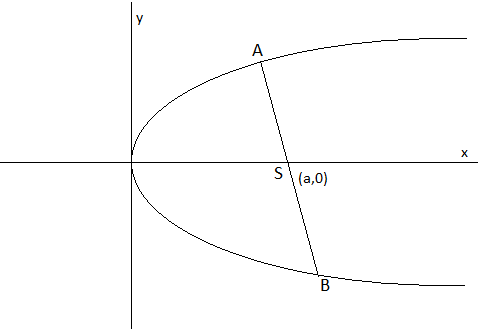
If l and l’ are the lengths of segment of focal chord of a parabola \[{{y}^{2}}=4ax\], then prove that \[\dfrac{1}{l}+\dfrac{1}{l'}=\dfrac{1}{a}\].
Answer
592.5k+ views
Hint: In the above question we will use the parametric form of the parabola \[{{y}^{2}}=4ax\] which is \[\left( a{{t}^{2}},2at \right)\]. We will use the property of a focal chords, if one end of a focal chord A \[=\left( a{{t}_{1}}^{2},2a{{t}_{1}} \right)\] and the other end of a focal chord B \[=\left( a{{t}_{2}}^{2},2a{{t}_{2}} \right)\] then \[{{t}_{1}}{{t}_{2}}=-1\].
Complete step-by-step answer:
We will also use the distance formula between two points \[\left( {{x}_{1}},{{y}_{1}} \right)\] and \[\left( {{x}_{2}},{{y}_{2}} \right)\] as follows:
Distance \[=\sqrt{{{\left( {{x}_{1}}-{{x}_{2}} \right)}^{2}}+{{\left( {{y}_{1}}-{{y}_{2}} \right)}^{2}}}\]
We have been given a parabola \[{{y}^{2}}=4ax\] and l and l’ are the lengths of segment of focal chord of parabola and then we have to prove \[\dfrac{1}{l}+\dfrac{1}{l'}=\dfrac{1}{a}\].
We know the parametric form of the parabola \[{{y}^{2}}=4ax\] is \[\left( a{{t}^{2}},2at \right)\].
Let us suppose the end points of focal chord A \[\left( a{{t}_{1}}^{2},2a{{t}_{1}} \right)\] and the other end point B \[\left( a{{t}_{2}}^{2},2a{{t}_{2}} \right)\].
By the property of focal chords we know that \[{{t}_{1}}{{t}_{2}}=-1\]
\[\Rightarrow {{t}_{2}}=\dfrac{-1}{{{t}_{1}}}\]
On substituting the value of \[{{t}_{2}}\] in point B, we get as follows:
\[\begin{align}
& a{{t}_{2}}^{2}=a{{\left( \dfrac{-1}{{{t}_{1}}} \right)}^{2}}=\dfrac{a}{{{t}_{1}}^{2}} \\
& 2a{{t}_{2}}=2a\left( \dfrac{-1}{{{t}_{1}}} \right)=\dfrac{-2a}{{{t}_{1}}} \\
\end{align}\]
So the point B is \[\left( \dfrac{a}{{{t}_{1}}^{2}},\dfrac{-2a}{{{t}_{1}}} \right)\].
Also, focus is S = (a,0)

We know the distance formula between two points \[\left( {{x}_{1}},{{y}_{1}} \right)\] and \[\left( {{x}_{2}},{{y}_{2}} \right)\] as follows:
Distance \[=\sqrt{{{\left( {{x}_{1}}-{{x}_{2}} \right)}^{2}}+{{\left( {{y}_{1}}-{{y}_{2}} \right)}^{2}}}\]
By using the distance formula the length of segment of focal chords are as follows:
\[l=AS=\sqrt{{{\left( a{{t}_{1}}^{2}-a \right)}^{2}}+{{\left( 2a{{t}_{1}} \right)}^{2}}}\]
Using the identity \[{{\left( a-b \right)}^{2}}={{a}^{2}}-2ab+{{b}^{2}}\] in the above equation, we get as follows:
\[\begin{align}
& \Rightarrow \sqrt{{{a}^{2}}{{\left( {{t}_{1}}^{2}-1 \right)}^{2}}+4{{a}^{2}}{{t}_{1}}^{2}} \\
& \Rightarrow \sqrt{{{a}^{2}}{{t}_{1}}^{4}-2{{a}^{2}}{{t}_{1}}^{2}+{{a}^{2}}+4{{a}^{2}}{{t}_{1}}^{2}} \\
& \Rightarrow \sqrt{{{a}^{2}}{{t}_{1}}^{4}+2{{a}^{2}}{{t}_{1}}^{2}+{{a}^{2}}} \\
& \Rightarrow \sqrt{{{a}^{2}}{{\left( {{t}_{1}}^{2}+1 \right)}^{2}}} \\
& \Rightarrow a\left( {{t}_{1}}^{2}+1 \right) \\
\end{align}\]
\[l'=BS=\sqrt{{{\left( \dfrac{a}{{{t}_{1}}^{2}}-a \right)}^{2}}+{{\left( \dfrac{-2a}{{{t}_{1}}}-0 \right)}^{2}}}\]
Using the identity \[{{\left( a-b \right)}^{2}}={{a}^{2}}-2ab+{{b}^{2}}\] in the above equation, we get as follows:
\[\begin{align}
& \Rightarrow \sqrt{\dfrac{{{a}^{2}}}{{{t}_{1}}^{4}}-\dfrac{2{{a}^{2}}}{{{t}_{1}}^{2}}+{{a}^{2}}+\dfrac{4{{a}^{2}}}{{{t}_{1}}^{2}}} \\
& \Rightarrow \sqrt{\dfrac{{{a}^{2}}}{{{t}_{1}}^{4}}+\dfrac{2{{a}^{2}}}{{{t}_{1}}^{2}}+{{a}^{2}}} \\
& \Rightarrow \sqrt{{{\left( \dfrac{a}{{{t}_{1}}^{2}}+a \right)}^{2}}} \\
& \Rightarrow \dfrac{a}{{{t}_{1}}^{2}}+a=a\left( \dfrac{1}{{{t}_{1}}^{2}}+1 \right) \\
& \Rightarrow \dfrac{a\left( 1+{{t}_{1}}^{2} \right)}{{{t}_{1}}^{2}} \\
\end{align}\]
Now, \[\dfrac{1}{l}+\dfrac{1}{l'}=\dfrac{1}{a\left( {{t}_{1}}^{2}+1 \right)}+\dfrac{{{t}_{1}}^{2}}{a\left( {{t}_{1}}^{2}+1 \right)}\]
Taking \[\dfrac{1}{a\left( {{t}_{1}}^{2}+1 \right)}\] as common we get as follows:
\[\Rightarrow \dfrac{1}{a\left( {{t}_{1}}^{2}+1 \right)}\left[ 1+{{t}_{1}}^{2} \right]=\dfrac{1}{a}\]
Hence, it is proved that \[\dfrac{1}{l}+\dfrac{1}{l'}=\dfrac{1}{a}\].
Note: Be careful while doing calculation as there is a chance that you might make a sign mistake while using the distance formula as well as finding the value of ‘\[{{t}_{2}}\]’ in terms of ‘\[{{t}_{1}}\]’ by using the property of focal chord. Also remember that a focal chord means the chord that passes through the focus of the parabola.
Complete step-by-step answer:
We will also use the distance formula between two points \[\left( {{x}_{1}},{{y}_{1}} \right)\] and \[\left( {{x}_{2}},{{y}_{2}} \right)\] as follows:
Distance \[=\sqrt{{{\left( {{x}_{1}}-{{x}_{2}} \right)}^{2}}+{{\left( {{y}_{1}}-{{y}_{2}} \right)}^{2}}}\]
We have been given a parabola \[{{y}^{2}}=4ax\] and l and l’ are the lengths of segment of focal chord of parabola and then we have to prove \[\dfrac{1}{l}+\dfrac{1}{l'}=\dfrac{1}{a}\].
We know the parametric form of the parabola \[{{y}^{2}}=4ax\] is \[\left( a{{t}^{2}},2at \right)\].
Let us suppose the end points of focal chord A \[\left( a{{t}_{1}}^{2},2a{{t}_{1}} \right)\] and the other end point B \[\left( a{{t}_{2}}^{2},2a{{t}_{2}} \right)\].
By the property of focal chords we know that \[{{t}_{1}}{{t}_{2}}=-1\]
\[\Rightarrow {{t}_{2}}=\dfrac{-1}{{{t}_{1}}}\]
On substituting the value of \[{{t}_{2}}\] in point B, we get as follows:
\[\begin{align}
& a{{t}_{2}}^{2}=a{{\left( \dfrac{-1}{{{t}_{1}}} \right)}^{2}}=\dfrac{a}{{{t}_{1}}^{2}} \\
& 2a{{t}_{2}}=2a\left( \dfrac{-1}{{{t}_{1}}} \right)=\dfrac{-2a}{{{t}_{1}}} \\
\end{align}\]
So the point B is \[\left( \dfrac{a}{{{t}_{1}}^{2}},\dfrac{-2a}{{{t}_{1}}} \right)\].
Also, focus is S = (a,0)

We know the distance formula between two points \[\left( {{x}_{1}},{{y}_{1}} \right)\] and \[\left( {{x}_{2}},{{y}_{2}} \right)\] as follows:
Distance \[=\sqrt{{{\left( {{x}_{1}}-{{x}_{2}} \right)}^{2}}+{{\left( {{y}_{1}}-{{y}_{2}} \right)}^{2}}}\]
By using the distance formula the length of segment of focal chords are as follows:
\[l=AS=\sqrt{{{\left( a{{t}_{1}}^{2}-a \right)}^{2}}+{{\left( 2a{{t}_{1}} \right)}^{2}}}\]
Using the identity \[{{\left( a-b \right)}^{2}}={{a}^{2}}-2ab+{{b}^{2}}\] in the above equation, we get as follows:
\[\begin{align}
& \Rightarrow \sqrt{{{a}^{2}}{{\left( {{t}_{1}}^{2}-1 \right)}^{2}}+4{{a}^{2}}{{t}_{1}}^{2}} \\
& \Rightarrow \sqrt{{{a}^{2}}{{t}_{1}}^{4}-2{{a}^{2}}{{t}_{1}}^{2}+{{a}^{2}}+4{{a}^{2}}{{t}_{1}}^{2}} \\
& \Rightarrow \sqrt{{{a}^{2}}{{t}_{1}}^{4}+2{{a}^{2}}{{t}_{1}}^{2}+{{a}^{2}}} \\
& \Rightarrow \sqrt{{{a}^{2}}{{\left( {{t}_{1}}^{2}+1 \right)}^{2}}} \\
& \Rightarrow a\left( {{t}_{1}}^{2}+1 \right) \\
\end{align}\]
\[l'=BS=\sqrt{{{\left( \dfrac{a}{{{t}_{1}}^{2}}-a \right)}^{2}}+{{\left( \dfrac{-2a}{{{t}_{1}}}-0 \right)}^{2}}}\]
Using the identity \[{{\left( a-b \right)}^{2}}={{a}^{2}}-2ab+{{b}^{2}}\] in the above equation, we get as follows:
\[\begin{align}
& \Rightarrow \sqrt{\dfrac{{{a}^{2}}}{{{t}_{1}}^{4}}-\dfrac{2{{a}^{2}}}{{{t}_{1}}^{2}}+{{a}^{2}}+\dfrac{4{{a}^{2}}}{{{t}_{1}}^{2}}} \\
& \Rightarrow \sqrt{\dfrac{{{a}^{2}}}{{{t}_{1}}^{4}}+\dfrac{2{{a}^{2}}}{{{t}_{1}}^{2}}+{{a}^{2}}} \\
& \Rightarrow \sqrt{{{\left( \dfrac{a}{{{t}_{1}}^{2}}+a \right)}^{2}}} \\
& \Rightarrow \dfrac{a}{{{t}_{1}}^{2}}+a=a\left( \dfrac{1}{{{t}_{1}}^{2}}+1 \right) \\
& \Rightarrow \dfrac{a\left( 1+{{t}_{1}}^{2} \right)}{{{t}_{1}}^{2}} \\
\end{align}\]
Now, \[\dfrac{1}{l}+\dfrac{1}{l'}=\dfrac{1}{a\left( {{t}_{1}}^{2}+1 \right)}+\dfrac{{{t}_{1}}^{2}}{a\left( {{t}_{1}}^{2}+1 \right)}\]
Taking \[\dfrac{1}{a\left( {{t}_{1}}^{2}+1 \right)}\] as common we get as follows:
\[\Rightarrow \dfrac{1}{a\left( {{t}_{1}}^{2}+1 \right)}\left[ 1+{{t}_{1}}^{2} \right]=\dfrac{1}{a}\]
Hence, it is proved that \[\dfrac{1}{l}+\dfrac{1}{l'}=\dfrac{1}{a}\].
Note: Be careful while doing calculation as there is a chance that you might make a sign mistake while using the distance formula as well as finding the value of ‘\[{{t}_{2}}\]’ in terms of ‘\[{{t}_{1}}\]’ by using the property of focal chord. Also remember that a focal chord means the chord that passes through the focus of the parabola.
Recently Updated Pages
Master Class 8 Maths: Engaging Questions & Answers for Success

Class 8 Question and Answer - Your Ultimate Solutions Guide

Master Class 7 Maths: Engaging Questions & Answers for Success

Class 7 Question and Answer - Your Ultimate Solutions Guide

Master Class 6 Maths: Engaging Questions & Answers for Success

Class 6 Question and Answer - Your Ultimate Solutions Guide

Trending doubts
What is meant by exothermic and endothermic reactions class 11 chemistry CBSE

Which animal has three hearts class 11 biology CBSE

10 examples of friction in our daily life

One Metric ton is equal to kg A 10000 B 1000 C 100 class 11 physics CBSE

1 Quintal is equal to a 110 kg b 10 kg c 100kg d 1000 class 11 physics CBSE

Difference Between Prokaryotic Cells and Eukaryotic Cells




